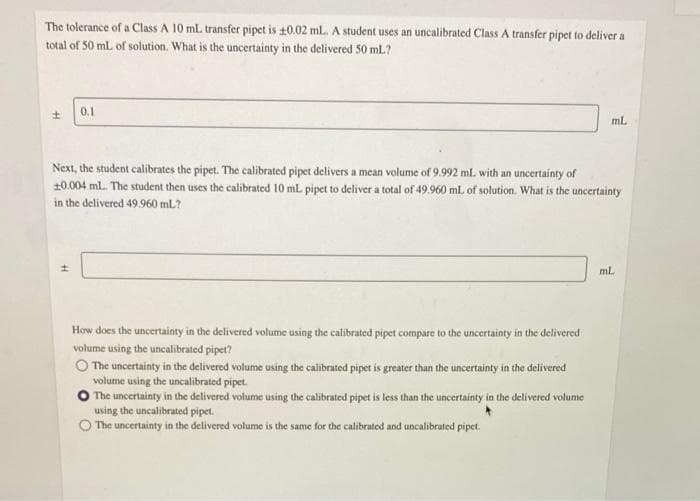The tolerance of a Class A 10 mL. transfer pipet is 10.02 mL. A student uses an uncalibrated Class A transfer pipet to deliver a total of 50 mL of solution. What is the uncertainty in the delivered 50 mL? ± 0.1 Next, the student calibrates the pipet. The calibrated pipet delivers a mean volume of 9.992 mL with an uncertainty of 10.004 ml. The student then uses the calibrated 10 mL pipet to deliver a total of 49.960 ml. of solution. What is the uncertainty in the delivered 49.960 mL? How does the uncertainty in the delivered volume using the calibrated pipet compare to the uncertainty in the delivered volume using the uncalibrated pipet? ml. The uncertainty in the delivered volume using the calibrated pipet is greater than the uncertainty in the delivered volume using the uncalibrated pipet. O The uncertainty in the delivered volume using the calibrated pipet is less than the uncertainty in the delivered volume using the uncalibrated pipet. The uncertainty in the delivered volume is the same for the calibrated and uncalibrated pipet. ml.
The tolerance of a Class A 10 mL. transfer pipet is 10.02 mL. A student uses an uncalibrated Class A transfer pipet to deliver a total of 50 mL of solution. What is the uncertainty in the delivered 50 mL? ± 0.1 Next, the student calibrates the pipet. The calibrated pipet delivers a mean volume of 9.992 mL with an uncertainty of 10.004 ml. The student then uses the calibrated 10 mL pipet to deliver a total of 49.960 ml. of solution. What is the uncertainty in the delivered 49.960 mL? How does the uncertainty in the delivered volume using the calibrated pipet compare to the uncertainty in the delivered volume using the uncalibrated pipet? ml. The uncertainty in the delivered volume using the calibrated pipet is greater than the uncertainty in the delivered volume using the uncalibrated pipet. O The uncertainty in the delivered volume using the calibrated pipet is less than the uncertainty in the delivered volume using the uncalibrated pipet. The uncertainty in the delivered volume is the same for the calibrated and uncalibrated pipet. ml.
Chemistry & Chemical Reactivity
9th Edition
ISBN:9781133949640
Author:John C. Kotz, Paul M. Treichel, John Townsend, David Treichel
Publisher:John C. Kotz, Paul M. Treichel, John Townsend, David Treichel
ChapterL: Let's Review
SectionL.2: Making Measurements: Precision, Accuracy, Experimental Error, And Standard Deviation
Problem 1RC
Related questions
Question
K 2

Transcribed Image Text:The tolerance of a Class A 10 mL transfer pipet is ±0.02 ml. A student uses an uncalibrated Class A transfer pipet to deliver a
total of 50 mL of solution. What is the uncertainty in the delivered 50 mL?
±
0.1
Next, the student calibrates the pipet. The calibrated pipet delivers a mean volume of 9.992 ml. with an uncertainty of
10.004 ml. The student then uses the calibrated 10 mL pipet to deliver a total of 49.960 mL of solution. What is the uncertainty
in the delivered 49.960 mL?
How does the uncertainty in the delivered volume using the calibrated pipet compare to the uncertainty in the delivered
volume using the uncalibrated pipet?
The uncertainty in the delivered volume using the calibrated pipet is greater than the uncertainty in the delivered
volume using the uncalibrated pipet.
ml.
The uncertainty in the delivered volume using the calibrated pipet is less than the uncertainty in the delivered volume
using the uncalibrated pipet.
The uncertainty in the delivered volume is the same for the calibrated and uncalibrated pipet.
ml.
Expert Solution
This question has been solved!
Explore an expertly crafted, step-by-step solution for a thorough understanding of key concepts.
This is a popular solution!
Trending now
This is a popular solution!
Step by step
Solved in 4 steps

Knowledge Booster
Learn more about
Need a deep-dive on the concept behind this application? Look no further. Learn more about this topic, chemistry and related others by exploring similar questions and additional content below.Recommended textbooks for you

Chemistry & Chemical Reactivity
Chemistry
ISBN:
9781133949640
Author:
John C. Kotz, Paul M. Treichel, John Townsend, David Treichel
Publisher:
Cengage Learning

Principles of Modern Chemistry
Chemistry
ISBN:
9781305079113
Author:
David W. Oxtoby, H. Pat Gillis, Laurie J. Butler
Publisher:
Cengage Learning


Chemistry & Chemical Reactivity
Chemistry
ISBN:
9781133949640
Author:
John C. Kotz, Paul M. Treichel, John Townsend, David Treichel
Publisher:
Cengage Learning

Principles of Modern Chemistry
Chemistry
ISBN:
9781305079113
Author:
David W. Oxtoby, H. Pat Gillis, Laurie J. Butler
Publisher:
Cengage Learning


Principles of Instrumental Analysis
Chemistry
ISBN:
9781305577213
Author:
Douglas A. Skoog, F. James Holler, Stanley R. Crouch
Publisher:
Cengage Learning